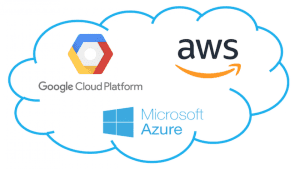Cloud computing is changing how businesses access, manage, and use IT resources. Businesses utilize cloud computing to access resources like storage, servers, networking, and analytics via the internet rather than maintaining extensive in-house gear and software. This approach offers flexibility, significant cost savings, and scalability. Microsoft Azure, one of the leading cloud providers, demonstrates the benefits of cloud computing by offering a wide range of solutions to meet the needs of businesses of all sizes.
Understanding Microsoft Azure

Microsoft Azure is a cloud computing platform and a suite of services designed for building, deploying, and managing applications through Microsoft’s data centers. Azure offers diverse services across infrastructure as a service (IaaS), platform as a service (PaaS), and software as a service (SaaS), supporting multiple programming languages, frameworks, and tools. Organizations can use Azure for everything from data storage and analytics to software delivery and backup solutions.
Key Benefits of Cloud Computing with Microsoft Azure
1. Cost Efficiency
- Benefit: Cloud computing eliminates the capital expenses associated with setting up and managing on-premises data centers, such as buying hardware, maintaining servers, and employing IT personnel.
- Example: A small retail business using Azure IaaS no longer needs to buy physical servers, allowing it to focus more on growth and customer satisfaction.
2. Speed and Flexibility
- Benefit: Microsoft Azure allows businesses to provision vast resources on demand. With just a few clicks, organizations can increase or decrease their capacity without requiring extensive setup.
- Example: A tech startup launching a new app used Azure’s auto-scaling to manage sudden traffic surges during the launch, enhancing customer experience.
3. Global Scale
- Benefit: Azure’s global infrastructure allows businesses to deploy their applications close to their end-users, minimizing latency and improving performance.
- Example: A media company streaming high-definition videos uses Azure’s Content Delivery Network (CDN) to ensure viewers worldwide experience minimal buffering.
4. Enhanced Productivity
- Benefit: Cloud computing reduces the time spent on IT management tasks, such as hardware setup and software maintenance. With Azure, IT teams can focus on strategic business initiatives instead.
- Example: A healthcare provider used Azure’s SaaS offerings to streamline administrative tasks, freeing up resources for patient care.
5. High Performance
- Benefit: Azure operates on high-performance infrastructure, with data centers constantly upgraded to deliver efficient processing power, lower latency, and increased reliability.
- Example: A finance firm uses Azure to run complex financial models, benefiting from faster processing times and enhanced computational power.
6. Reliable Data Backup and Recovery

- Benefit: Cloud storage with Microsoft Azure ensures data redundancy across multiple locations, which enhances data recovery options in case of disaster.
- Example: A law firm uses Azure for data backup and disaster recovery, keeping legal documents secure while ensuring quick recovery if an issue arises.
7. Robust Security Measures
- Benefit: Azure offers advanced security features, including multi-layered security measures, encryption, and compliance with global standards, helping organizations secure sensitive data.
- Example: A bank leverages Azure’s security features, ensuring compliance with regulatory requirements and enhancing trust with customers.
Types of Cloud Deployment Models
1. Public Cloud
Public clouds are operated by third-party providers like Microsoft Azure. Organizations access resources via the internet, while Azure manages the underlying infrastructure.
2. Private Cloud
A private cloud is dedicated to a single organization. Some companies choose to host their private cloud on-premises, while others use third-party providers like Azure.
3. Hybrid Cloud
Hybrid clouds combine public and private clouds, allowing organizations to leverage the benefits of both. Azure supports hybrid models, enabling seamless integration between on-premises infrastructure and cloud services.
Azure Cloud Service Models: IaaS, PaaS, SaaS, and Serverless

1. Infrastructure as a Service (IaaS)
IaaS provides on-demand computing infrastructure, such as virtual machines, storage, and networks. Organizations can quickly deploy and scale infrastructure based on business needs.
- Example: An e-commerce site uses Azure IaaS to handle high traffic volumes during sales events.
2. Platform as a Service (PaaS)
PaaS provides an environment for developing, testing, and deploying applications without managing the underlying hardware. It simplifies the development process for developers.
- Example: A software development company uses Azure PaaS to build, test, and deploy a mobile app without worrying about infrastructure setup.
3. Software as a Service (SaaS)
SaaS allows businesses to use cloud-based software applications without managing the underlying infrastructure. SaaS applications are typically subscription-based.
- Example: A non-profit organization uses Microsoft Office 365, a SaaS solution on Azure, to manage internal communications and document sharing.
4. Serverless Computing
Serverless allows developers to build and deploy applications without managing servers. Resources are allocated dynamically, and costs are based on actual usage.
- Example: A gaming company uses Azure’s serverless offerings to run in-game event triggers, optimizing costs and scaling as needed.
Use Cases and Applications of Cloud Computing

1. Data Storage and Backup
Cloud computing is ideal for data storage, backup, and recovery, offering high security and accessibility from any device with internet access.
- Example: A consulting firm backs up all project files on Azure, ensuring data accessibility and disaster recovery.
2. Cloud-Native Application Development
Azure’s PaaS and serverless options allow businesses to build applications that are scalable, resilient, and efficient.
- Example: A logistics company uses Azure to develop a tracking app with real-time data synchronization and GPS integration.
3. Streaming Media Content
Azure’s content delivery and media streaming solutions make it easy to deliver high-quality video and audio worldwide.
- Example: An online learning platform leverages Azure to stream educational content, ensuring students have a seamless viewing experience.
4. Data Analytics and Machine Learning
Azure offers analytics services that help organizations process large datasets, enabling data-driven decision-making.
- Example: A retail company uses Azure’s machine learning tools to analyze customer data, helping to predict trends and improve product offerings.
Real-World Case Studies Using Microsoft Azure
Retail Chain Improving Customer Experience
A major retail chain optimized its digital customer experience by migrating to Azure. Using Azure’s IaaS, the chain reduced server costs by 25% and improved website speed by 35%, leading to higher customer satisfaction.
Streamlining Operations at a Healthcare Provider
Azure SaaS solutions helped a healthcare provider streamline its processes, which gave its IT team more time to care for patients. Because of the migration, output went up by 20%, appointments were processed faster, and data security got better.
A financial institution is making data security better.
Azure’s compliance and multi-layered security features helped a major bank make its data safer. This move made customers trust the bank more and helped it meet strict government rules, which cut security risks by 40%.
Conclusion
With cloud computing, businesses can get more done, save money, and run more smoothly. This is especially true when they use Microsoft Azure to get to IT tools that can be scaled up or down as needed. You can find a service in Azure that fits all of your needs. It can be used in public, private, or a mixed way, depending on the needs of the business.
With IaaS, PaaS, SaaS, and serverless computing in Azure, businesses can adapt to new technologies without having to spend a lot of money on equipment. Businesses from all over the world can use it because of this. Cloud computing is now an important part of digital change that you can’t avoid if you want to stay ahead of the curve. Microsoft Azure is a good partner for businesses that want to grow, improve, and develop because it has so many features.










